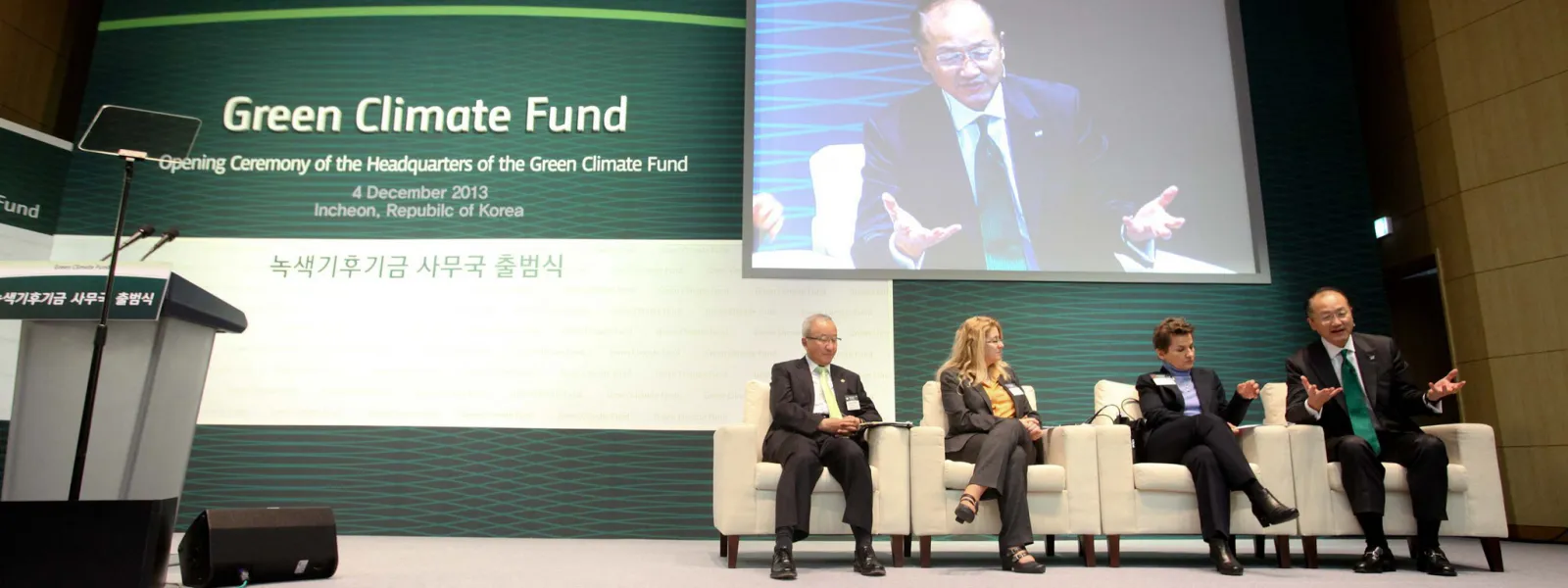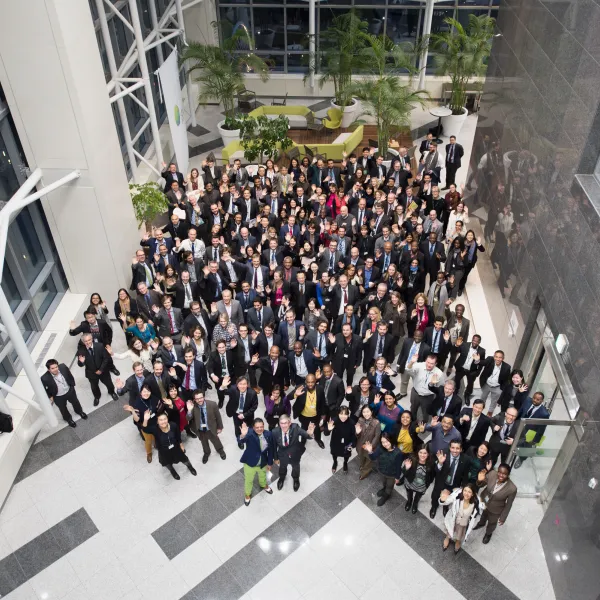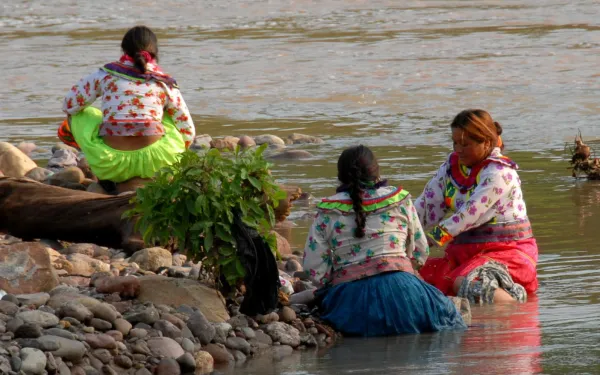
Project
Photo: GCFAdvocating before the Green Climate Fund
The Green Climate Fund is the world's leading multilateral climate finance institution. As such, it has a key role in channelling economic resources from developed to developing nations for projects focused on mitigation and adaptation in the face of the climate crisis.
Created in 2010, within the framework of the United Nations, the fund supports a broad range of projects ranging from renewable energy and low-emissions transportation projects to the relocation of communities affected by rising seas and support to small farmers affected by drought. The assistance it provides is vital so that individuals and communities in Latin America, and other vulnerable regions, can mitigate greenhouse gas emissions and address the increasingly devastating impacts of global warming.
Climate finance provided by the Green Climate Fund is critical to ensure the transformation of current economic and energy systems towards the resilient, low-emission systems that the planet urgently needs. To enable a just transition, it’s critical to follow-up on and monitor its operations, ensuring that the Fund effectively fulfills its role and benefits the people and communities most vulnerable to climate change.
Reports
Read our recent report "Leading participatory monitoring processes through a gender justice lens for Green Climate Fund financed projects" here.
Partners:

Related projects
AIDA critical of Colombian spraying in Ecuadorian border region
AIDA critical of Colombian spraying in Ecuadorian border region The Colombian government is violating a bilateral accord with Ecuador by spraying a mixture of herbicides intended to destroy coca crops within 10 kilometers of the Ecuadorian border. Colombia is relying on studies by a team from the Inter-American Drug Abuse Control Commission (CICAD) of the Organization of American States (OAS) to claim that the spray mixture is safe. AIDA’s independent review of CICAD's recent studies, however, shows that the pesticide mixture being sprayed has not, in fact, been proven safe for the environment, and that Ecuador has substantial cause to oppose the sprayings. The first CICAD Environmental and Human Health Assessment of the Aerial Spray Program for Coca and Poppy Control in Colombia, released in 2005, did not assess many of the greatest potential ecological and human health risks posed by the aerial eradication program in Colombia. The U.S. Congress requested further studies to determine whether the mixture is truly harmful to the environment. Preliminary results from the follow-up studies, released in August 2006, show that the mixture is indeed potentially harmful to the environment, and particularly to amphibians – the spray mixture killed 50 percent of the amphibians exposed within 96 hours. Additionally, the State Department has not provided adequate information about the location of and risk to sensitive water bodies and has done nothing to address whether other threatened species are likely to be harmed. Without these determinations, any claim by the Colombian government that the spray mixture is safe enough to spray along the Ecuadorian border is misinformed.
Read moreAIDA Calls for Alternative Development Programs in Colombia
AIDA Report Highlights Need for Alternative Programs in Colombia After six years of spraying herbicides over large areas of the Colombian countryside under "Plan Colombia," the aerial spraying program has failed to meet the goal of eliminating 50 percent of illicit crops in this country. Despite an investment of nearly US$1.2 billion, and the spraying of more than four times the initial area of coca crops, coca cultivation in Colombia continues, at nearly the same levels as when the program originated. Meanwhile, the spraying continues to cause severe social impacts and pose unknown environmental risk. AIDA has prepared a report analyzing some of the participatory, sustainable, alternative development programs that have proven more effective than aerial spraying. The report recommends that the U.S. and Colombian governments reevaluate the current policy and substantially increase support for such alternatives. The report highlights the need for a comprehensive approach to the problem of illegal crop cultivation, with a strategy that addresses the root-causes of the problem. The report provides detailed information and an analysis of five programs implemented by different actors, all of which can serve as models or provide lessons learned for new programs. Although improvements can still be made, alternative development programs have yielded concrete, positive results and have been far more cost-effective than the spraying program.
Read more
Legal victory! - Peruvian Constitutional Tribunal Orders the Government to Address the Public Health Emergency in La Oroya
FOR IMMEDIATE RELEASE: May 12, 2006 Contact: Dr. Anna Cederstav, Earthjustice/AIDA, (English) (510) 457-4010 [email protected] Dr. Carlos Chirinos, SPDA, (Spanish) (+511) 441-9171 [email protected] Hunter Farrell, MOSAO/Technical Roundtable, English (+511) 97094921 Legal victory! Peru Supreme Court Demands Government Protect Public Health from Doe Run Smelter in La Oroya LIMA, PERU — Peru's Supreme Court has given the Ministry of Health 30 days to declare a health emergency in La Oroya, and to put in place an emergency health plan for the city, widely considered one of the most contaminated cities in the Western Hemisphere. The city is the home of a multi-metal smelter, owned and operated by the Doe Run Company of St. Louis, Missouri, one of the companies owned by Mr. Ira Rennert and the Renco group of New York. While the ruling named the Health Ministry as the agency primarily responsible for protecting the health of La Oroya's population, it also called on the Doe Run Company to reduce toxic contamination and protect public health in La Oroya. The ruling requires the Health Ministry to pay special attention to health risks faced by children and pregnant women. “This is great news for the citizens of La Oroya, who have received justice from the Courts, and who -- in spite of having been threatened and persecuted for their role in demanding health protection in La Oroya -- had faith that justice would prevail,” said Dr. Carlos Chirinos, the attorney with the Peruvian Society for Environmental Law responsible for bringing the case almost four years ago. An initial victory in the lower court had been immediately appealed by Peru's Health Ministry, forcing the plaintiffs to bring the suit to the Supreme Court. The Supreme Court ruling allows 30 days for the Health Ministry to declare a health emergency in La Oroya, an action demanded by the Movement for Health in La Oroya (MOSAO) since 2003. A spokeswoman for the group, Dr. Eliana Ames, expressed satisfaction with the ruling: "This is the first time the Peruvian Government has acted to defend the health of all La Oroya's children and population." Earlier efforts of Peru's Environmental Health Authority (DIGESA) were limited to a few hundred of La Oroya's estimated 10,000 children, more than 97% of whom suffer from excessive levels of lead, according to last year's study by the St. Louis University's Public Health School. A related request to protect health by issuing precautionary measures for La Oroya is still pending before the Inter-American Commission on Human Rights. This case was brought by AIDA (Interamerican Association for Environmental Defense), Earthjustice, CEDHA (Center for Human Rights and Environment), and Carlos Chirinos.
Read more